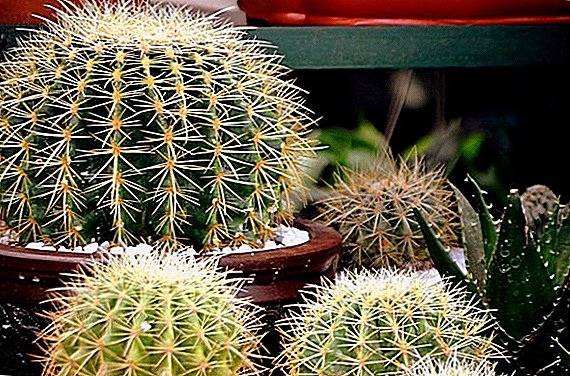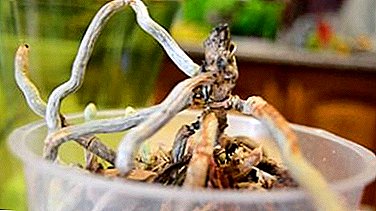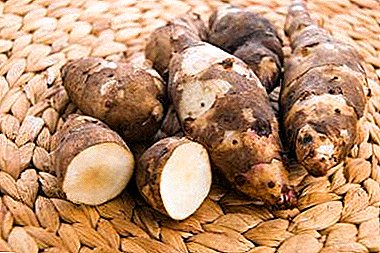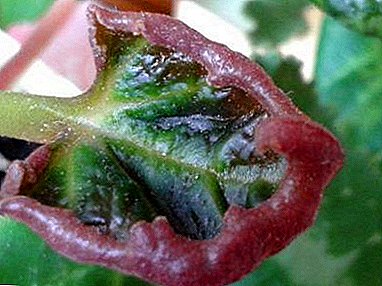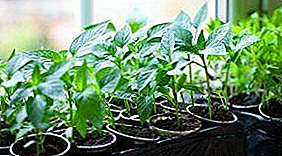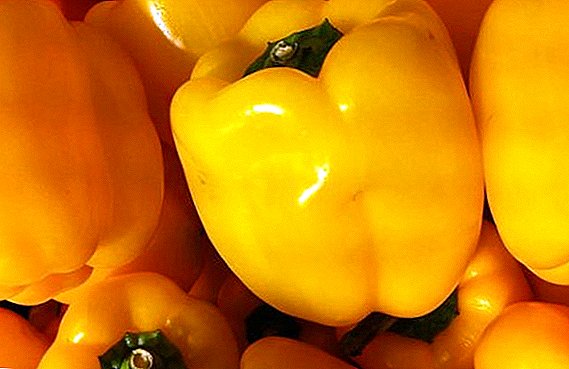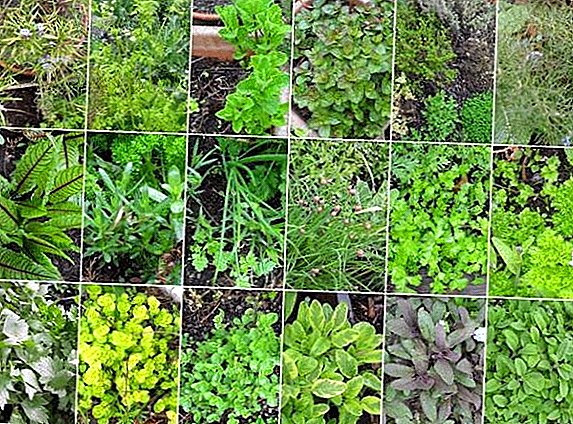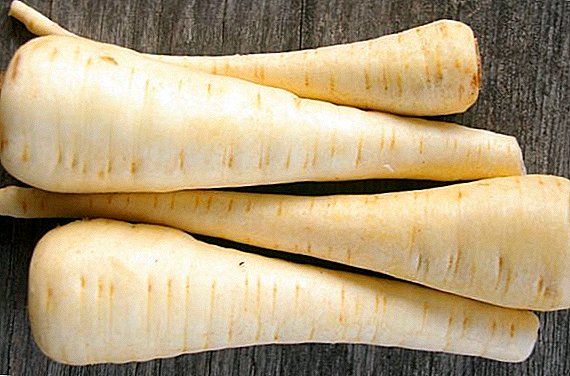 Parsnip - one of the most famous root crops in our region. This vegetable is defined to the Umbrella family. Its population is large enough that, along with a unique set of useful qualities, makes parsnip almost indispensable for many areas of human life: nutrition, traditional pharmacology and traditional medicine, cosmetology. The properties of parsnip are multifaceted, which is why you need to know about it as much as possible.
Parsnip - one of the most famous root crops in our region. This vegetable is defined to the Umbrella family. Its population is large enough that, along with a unique set of useful qualities, makes parsnip almost indispensable for many areas of human life: nutrition, traditional pharmacology and traditional medicine, cosmetology. The properties of parsnip are multifaceted, which is why you need to know about it as much as possible.
Chemical composition of parsnip
The composition of the parsnip is multifaceted and includes a large number of components, which determines the diversity of its useful properties. The plant sap contains a small amount of calcium and sodium, but the parsnip is saturated with sulfur, phosphorus, potassium, chlorine and silicon.
 Pasternak, whose caloric value and nutritional value is not as great as that of individual vegetable tubers, has significant beneficial properties of individual parts and the plant as a whole, which is noted by experts in various fields. The high concentration of sulfur and silicon in the chemical composition of parsnip helps protect the nail from brittleness. Chlorine and phosphorus, which is useful for the respiratory tract, predetermine the unique benefits of parsnip for people prone to lung diseases.
Pasternak, whose caloric value and nutritional value is not as great as that of individual vegetable tubers, has significant beneficial properties of individual parts and the plant as a whole, which is noted by experts in various fields. The high concentration of sulfur and silicon in the chemical composition of parsnip helps protect the nail from brittleness. Chlorine and phosphorus, which is useful for the respiratory tract, predetermine the unique benefits of parsnip for people prone to lung diseases.
The percentage of potassium, which is quite important and valuable to the brain, is also very high, which is why parsnips are often used to increase brain activity.
Did you know? For the first time, parsnip is mentioned only in the 1st century BC. Eminent Roman scientists and discoverers - Pliny and Dioscorides - noted its extraordinary useful properties. Later, during the excavation of the Neolithic settlements, remains of root crops and seeds of this plant were found. Pasternak appeared on the territory of our country approximately in the XYII century and was called “field soup”.
Calorie and nutritional value of parsnip
The calorie content of parsnip is 47 kcal / 100 g of fresh produce. Nutritional value of parsnip fruit per 100 g of fresh product: 9.2 g of carbohydrates, 1.4 g of proteins, 0.5 g of fat.
The benefits of parsnips for the human body
The benefits of this vegetable for the human body is invaluable. That is why it is often included in the compositions of drugs and prescriptions of traditional medicine. Pasternak, whose medical recipes are available and widely known, effectively affects various systems of the body and supports their health.
For hormonal background
 Due to the multicomponent and unique chemical composition, parsnips, characterized by a high concentration of essential oils and other active substances and biological components, contribute to the revitalization of the human glands. Thus, the beneficial properties of this fetus are valuable for stimulating the production of various enzymes in the body and the effect on the release of individual hormones. Not in vain in folk medicine, parsnip is considered to be a vegetable, which effectively contributes to maintaining vitality and increasing sexual activity. It is noteworthy that this is especially effective in people of the age for whom it plays an irreplaceable role.
Due to the multicomponent and unique chemical composition, parsnips, characterized by a high concentration of essential oils and other active substances and biological components, contribute to the revitalization of the human glands. Thus, the beneficial properties of this fetus are valuable for stimulating the production of various enzymes in the body and the effect on the release of individual hormones. Not in vain in folk medicine, parsnip is considered to be a vegetable, which effectively contributes to maintaining vitality and increasing sexual activity. It is noteworthy that this is especially effective in people of the age for whom it plays an irreplaceable role.
For breathing
Pasternak is one of the most useful fruits for diseases of the respiratory system and the respiratory system as a whole. This fact is caused by the fact that the use of vegetables favorably affects the condition of the bronchi and lungs of people suffering from tuberculosis and asthma. Many experts note that the beneficial properties of parsnip can significantly help in the fight against emphysema. High concentrations of ascorbic acid and carotene, which are part of the chemical composition of vegetables, have a positive effect on immunity and reducing the risk of colds. With the development of such diseases perfectly helps decoction and infusion.
For digestion
 The high concentration of essential oils in parsnip and its very specific taste triggers an active release of digestive enzymes and gastric juice. This helps to increase appetite and increase the speed of digestion. The benefit of this vegetable is also in its extremely low nutritional value, since the root of parsnip contains several times less calories than even celery. Because of this, eating this vegetable will not affect the weight and condition of the figure.
The high concentration of essential oils in parsnip and its very specific taste triggers an active release of digestive enzymes and gastric juice. This helps to increase appetite and increase the speed of digestion. The benefit of this vegetable is also in its extremely low nutritional value, since the root of parsnip contains several times less calories than even celery. Because of this, eating this vegetable will not affect the weight and condition of the figure.
However, it is worth noting that over-consuming parsnip, whose caloric content is low, is not necessary for people suffering from diseases of the digestive system, since benefits can quickly be replaced by undesirable side effects.
For the kidneys and bladder
The health of the organs of the human excretory system can be maintained due to the diuretic properties of parsnips. The processes caused by the substances of parsnip, stimulate the dissolution of stones and prevent the re-absorption of urine. As a result, parsnips have a positive effect on the excretory system as a whole. In addition, the parsnip itself and derivatives based on it are recommended to be taken in case of manifestation of inflammatory processes in prostatitis, inflammation of the gall and bladder, cystitis.
Important! It should be borne in mind that parsnip is strictly contraindicated in urolithiasis in the later stages, since it can stimulate the onset of the stones. Moreover, a significant use of this product can cause blockage of the urinary tract with large stones.
Parsnip-based products
 Drug development of parsnip in recent times is gaining high momentum, which is not surprising because of the large number of useful substances and a variety of properties. Already, the furocoumarin extract from parsnip (Bergapten and Xantoxin) serves as the basis for a number of pharmaceutical products for various purposes. These include "Pastinacin" and "Beroxan", which have antispasmodic and photosensitizing effects, respectively.
Drug development of parsnip in recent times is gaining high momentum, which is not surprising because of the large number of useful substances and a variety of properties. Already, the furocoumarin extract from parsnip (Bergapten and Xantoxin) serves as the basis for a number of pharmaceutical products for various purposes. These include "Pastinacin" and "Beroxan", which have antispasmodic and photosensitizing effects, respectively.
Due to a certain set of specific enzymes and substances in the composition of the parsnip, preparations produced on its basis are distinguished from a number of pharmaceutical products by their uniqueness.
For Beroxan, the effect achieved is as follows:
- activation of regenerative processes of skin pigmentation, as well as hair growth during alopecia;
- stimulation of melanin formation in cases of ultraviolet irradiation;
- restoration of skin sensitivity to sunlight;
- effective resistance to vitiligo disease.
Tablets are taken orally. In accordance with the prescription of a doctor, “Beroxan” is taken 1–4 times a day, at a dose of 0.02 grams, 4–1 hours, respectively, before the sessions of exposure to long-wave ultraviolet rays. The course of such treatment is 5 sessions of radiation, between which there must be a three-week break. The maximum soluble dosage of the drug - no more than 6 grams.
The action of "Pastinacin" is to:
- relaxation of muscle spasms of the intestines and coronary vessels;
- sedative effect;
- effective treatment of neurosis, coronary heart disease, angina attacks, various forms and types of coronary insufficiency (coronaroneurosis and coronarocardiosclerosis).
Important! An overdose of drugs based on parsnip can cause a number of undesirable side effects. The dosage and duration of the course of taking this drug should be coordinated with a qualified doctor.
Use in folk medicine: treatment with parsnips
 Pasternak in folk medicine has gained considerable popularity and widespread. For therapeutic purposes, used infusions, decoctions and even the juice of this amazing vegetable. It is noteworthy that the chemical composition of the plant allows its use in traditional and folk treatment. The benefits of parsnip for men and women are irrefutable, so it is advisable to know the most effective recipes.
Pasternak in folk medicine has gained considerable popularity and widespread. For therapeutic purposes, used infusions, decoctions and even the juice of this amazing vegetable. It is noteworthy that the chemical composition of the plant allows its use in traditional and folk treatment. The benefits of parsnip for men and women are irrefutable, so it is advisable to know the most effective recipes.
Parsnip juice
Parsnip juice is an excellent remedy recommended for general breakdown. Along with this, drinking juice can improve digestion, increase appetite, and strengthen the walls of blood vessels and capillaries. The juice of this vegetable is characterized by a strong expectorant property, as well as a tonic and analgesic effect.
Parsnip juice is often prescribed in the treatment and prevention of cardiovascular diseases of varying complexity (coronary insufficiency, neurosis, strokes, coronaspasms, etc.), renal, gastric, and hepatic colic. Moreover, taking the juice in accordance with the recommendations is effective in edematous states. Separate chemical components in the composition of parsnip make its juice a peculiar pathogen and activator of sexual function.
To achieve the medical effect of parsnip juice, mixed with honey, you need to take 1-2 teaspoons for half an hour before meals.
Important! For medicinal purposes, you can use only the juice pressed from the root! In the stem and seeds of the vegetable is a high concentration of substances that can cause side effects.
Parsnip leaf tea with calming effect
 Tea from parsnip has long been used in folk medicine as a potent means of quickly getting rid of delirium tremens and hallucinations. The calming effect of parsnip leaf tea contributes to the stabilization of the nervous system, as well as filling the body with a healthy mind and new energy. Tea prepared according to a similar recipe, activates the restoration of melanin in the body, lost from exposure to ultraviolet rays.
Tea from parsnip has long been used in folk medicine as a potent means of quickly getting rid of delirium tremens and hallucinations. The calming effect of parsnip leaf tea contributes to the stabilization of the nervous system, as well as filling the body with a healthy mind and new energy. Tea prepared according to a similar recipe, activates the restoration of melanin in the body, lost from exposure to ultraviolet rays.
To make tea, you need chopped, dried stems of parsnip mixed with linden and honey, pouring the mixture with a liter of boiling water. Present and carefully filtered tea retains its useful properties for up to 3 days, but it is desirable to make a fresh infusion daily.
Decoction of parsnip leaves
The decoction of leaves of parsnip is one of the most effective and popular modern means of traditional medicine, which, along with the simplicity and affordability of the recipe, demonstrates outstanding efficiency. A decoction of the leaves is used in the treatment of a number of diseases, and there is practically no alternative means of effectiveness.
- Decoction of parsnip leaves with baldness
- Broth leaves with renal and urolithiasis
 Decoction of the leaves shows good results in the treatment of kidney and urolithiasis. For the manufacture of decoction you need 1 tbsp. l Chop up the prepared and dried leaves thoroughly, pour 1 liter of filtered water and boil for 30 minutes, then strain thoroughly and put for a day in a warm, dark place. The recommended rate of reception of such a decoction - 1 tbsp. l 3 times a day.
Decoction of the leaves shows good results in the treatment of kidney and urolithiasis. For the manufacture of decoction you need 1 tbsp. l Chop up the prepared and dried leaves thoroughly, pour 1 liter of filtered water and boil for 30 minutes, then strain thoroughly and put for a day in a warm, dark place. The recommended rate of reception of such a decoction - 1 tbsp. l 3 times a day.- Broth leaves with colic
Parsnip roots decoction
A decoction of the root parsnip is recommended to take to fight inflammatory processes, colds, disorders of the nervous system and other problems. It is noteworthy that the effectiveness of decoction of parsnip roots, prepared according to traditional medicine recipes, in some cases significantly exceeds the effectiveness of traditional medicine preparations.
- Broth with colds and cough
- Decoction against hair loss
- Broth roots from depression
 The chemical composition of parsnip is characterized by a high concentration of substances that have a beneficial effect on the nervous system; therefore, a decoction of this vegetable is often used to combat depression.
The chemical composition of parsnip is characterized by a high concentration of substances that have a beneficial effect on the nervous system; therefore, a decoction of this vegetable is often used to combat depression.For the preparation of this tool you need to prepare one crushed parsnip root in advance prepared with 50 g of honey, 5 mint leaves, 5 linden blossoms and pour 2 liters of water. It is necessary to boil the broth for half an hour, and then insist for a day. Drink a decoction of the roots of parsnip 3 times a day, regardless of meals.
Parsnip infusion
 In the recipe of traditional medicine there are a lot of various options for infusion of parsnips, which are equally effective in treating many diseases. It is noteworthy that in the end result, the infusion of parsnips includes a permanent list of components.
In the recipe of traditional medicine there are a lot of various options for infusion of parsnips, which are equally effective in treating many diseases. It is noteworthy that in the end result, the infusion of parsnips includes a permanent list of components.
To prepare the infusion, you must carefully chop a large vegetable root, tamp it in a container before extracting the juice and pour 0.5 liters of vodka. Insist composition must be within a month in a dark place, occasionally stirring and shaking.
The resulting tincture is strongly recommended to take no more than three times a day, one teaspoon.
Did you know? Pasternak and derivatives based on it (especially on the basis of the root) can effectively relieve spasms of blood vessels and reduce pressure. It is often used to treat hypertension, muscle cramps and even angina pectoris.
How to use parsnips in cosmetology
Pasternak, the benefits and harms of which have already been proven in traditional and traditional medicine, is also widely used in cosmetology. The rich mineral complex and the presence of ascorbic acid in the chemical composition of this plant predetermines the fact that modern cosmetology is practically impossible without the use of parsnip in one form or another.
 Essential oil, contained in the root vegetables of parsnip, it is common to use for cellulite, treatment of acne and other skin inflammations, as well as for smoothing small and formed wrinkles. Antioxidant properties Plants can effectively use the extract for the treatment of dermatological diseases, however, the most widespread pasternak in cosmetology has gained as the basis for masks.
Essential oil, contained in the root vegetables of parsnip, it is common to use for cellulite, treatment of acne and other skin inflammations, as well as for smoothing small and formed wrinkles. Antioxidant properties Plants can effectively use the extract for the treatment of dermatological diseases, however, the most widespread pasternak in cosmetology has gained as the basis for masks.
These products are characterized by an incredible whitening effect, and also nourish the skin. It is noteworthy that you can enjoy such masks not only in expensive cosmetic centers, but also by preparing them yourself at home.
- An anti-wrinkle parsnip mask.
- Parsnip root - 1 pc .;
- Vegetable oil - 1 tsp;
- Egg yolk - 1 pc .;
- Honey - 1 tsp;
- Water - 0.5 l.
- Mask on the basis of parsnip against skin inflammation
- Parsnip root - 1 pc .;
- Mint leaves - 5 pcs .;
- Honey - 1 tbsp. l .;
- Vegetable oil - 2 tbsp. l
 Parsnip root must be grated on a fine grater and chopped mint leaves. The resulting components are mixed and crushed in a bowl until the selection of the juice. After that, the composition is charged with honey and vegetable oil. This cosmetic should be applied on the face in a circular motion and hold for 10-15 minutes, then rinse with micellar water.
Parsnip root must be grated on a fine grater and chopped mint leaves. The resulting components are mixed and crushed in a bowl until the selection of the juice. After that, the composition is charged with honey and vegetable oil. This cosmetic should be applied on the face in a circular motion and hold for 10-15 minutes, then rinse with micellar water.Important! Prolonged skin contact with chemicals of parsnip can significantly increase its sensitivity to factors of various kinds. Therefore, it is strongly recommended to follow the rules of applying a cosmetic mask based on this plant.
How to prepare raw materials from parsnip for medicinal purposes
Useful properties of parsnip predetermine active use of raw materials from parsnip for medicinal purposes. All parts of the plant are useful, therefore they harvest the roots, stems and fruits of parsnip. The recommended method of preparation is determined by the further use of raw materials, so it is important to consider this factor.
Important! For harvesting, you can use only parsnips that have no external damage and cracks. Their presence is an indicator of obvious diseases - such fruits, regardless of the methods of harvesting, are less useful and will not be stored for a long time.
 Parsnip root vegetables are used both fresh and dried. Their harvesting is done in late autumn (as a rule, at the end of the autumn harvest) when the weather is dry and the ground is a bit damp. Pasternak, the root of which is gentle enough, you need to gently undermine the garden fork and slowly pull out the tops. Subsequently, the above-ground part is cut, and the roots are dried in an accessible way.
Parsnip root vegetables are used both fresh and dried. Their harvesting is done in late autumn (as a rule, at the end of the autumn harvest) when the weather is dry and the ground is a bit damp. Pasternak, the root of which is gentle enough, you need to gently undermine the garden fork and slowly pull out the tops. Subsequently, the above-ground part is cut, and the roots are dried in an accessible way.
Did you know? Roots can be quickly dried in the oven. To do this, select the selected roots carefully cut into strips about 3 cm thick and place on a baking sheet in an oven preheated to 50 ° C. It is necessary to dry raw materials for 10-20 minutes, stirring occasionally. Store dried root in a glass jar.
For fresh use, the roots should be put in the basement or cellar for storage. It is best to place them in wet sand, which will significantly extend the shelf life.
The stems of parsnip with leaves (grass plants) must be harvested during flowering. Cut stems should be carefully spread out in a thin layer on a sheet of paper or thick fabric and dried in the open air, protected from shade and drafts. For proper drying, they need to be stirred periodically.
 The preparation of the fruit of the parsnip is made after reaching full maturity. After harvesting and drying umbrellas, they are thoroughly cleaned of seeds. The collected seeds, which are fruits, should be placed in a dry glass jar. You can store fruits harvested this way for 3 years.
The preparation of the fruit of the parsnip is made after reaching full maturity. After harvesting and drying umbrellas, they are thoroughly cleaned of seeds. The collected seeds, which are fruits, should be placed in a dry glass jar. You can store fruits harvested this way for 3 years.
What kind of harm can parsnip do?
Despite the use of parsnip with a different purpose and in different areas, it can also cause harm. So, even a slight contact of wet areas of the skin with the fruits or individual leaves of this plant can provoke the occurrence of burns of varying degrees. Especially carefully and reverently treat this plant is worth people who have light and super sensitive skin.
This is due to the fact that contact with parsnips can increase the sensitivity of human skin to sunlight. Moreover, the composition of the parsnip includes potent substances, therefore, contraindications include individual intolerance.
 Pasternak is considered to be one of the most useful root crops. For various reasons, it is often underestimated, but this in no way affects the widespread and highly efficient use of parsnip in various areas of human life.
Pasternak is considered to be one of the most useful root crops. For various reasons, it is often underestimated, but this in no way affects the widespread and highly efficient use of parsnip in various areas of human life.


